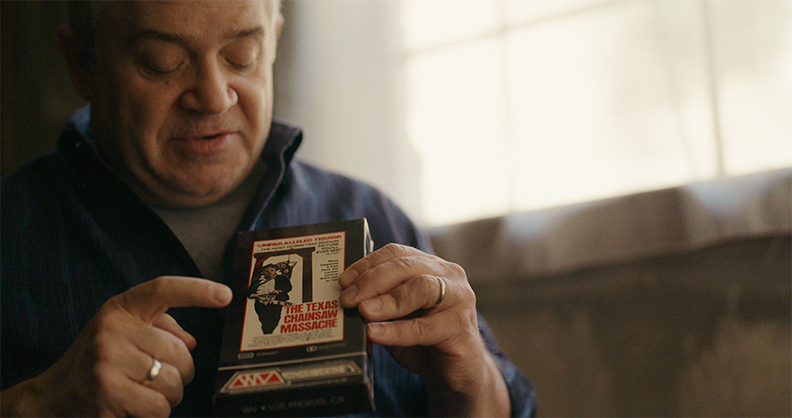
The Film That Keeps Cutting Into Culture
MOVIE REVIEW
Chain Reactions
–
Genre: Documentary
Year Released: 2025
Runtime: 1h 43m
Director(s): Alexandre O. Philippe
Where to Watch: opens in select theaters September 19, 2025, expands nationwide September 26
RAVING REVIEW: CHAIN REACTIONS isn’t a “making-of.” It’s a meditation on why a scrappy 1970s horror film keeps rattling around in our collective headspace, and how it continues to shape artists five decades later. Alexandre O. Philippe treats the subject with the same introspective rigor that has become his signature: isolating a foundational text, assembling an eclectic group of icons, and asking not what happened on set, but what the film did—and still does—to our senses, our anxieties, and our art. The result is a confident, idea-forward documentary that’s equal parts criticism, confession, and cinematic séance.
Rather than piling on a chorus of talking heads, Philippe narrows the field to five carefully chosen voices and lets them breathe. That constraint pays off. Patton Oswalt, Takashi Miike, Alexandra Heller-Nicholas, Stephen King, and Karyn Kusama don’t repeat trivia; they spin personal perspectives around a single title and, crucially, around the textures through which they first encountered it. The emphasis on format—16mm, 35mm, VHS, digital—isn’t a gimmick. It’s the thesis. How we watch becomes part of what we watch. A beat-up print or a warped cassette can turn terror tactile; a pristine restoration can reveal a brutal kind of beauty hiding in plain sight. CHAIN REACTIONS argues that the film’s legend isn’t just the movie—it’s the sum of a thousand viewings and moving parts.
As a grouping, the five participants complement one another with surprising harmony. Oswalt’s cinephile poetry refracts a fan’s love through a critic’s eye. Miike’s recollections land with visceral force, tracing a line between teenage awakening and a career spent threading taboos. Heller-Nicholas pulls the conversation toward materiality and scholarship—the way a specific tape stock or distribution path can tint the film’s afterlife. King brings an almost mischievous authority, framing the work as a lean, inexorable engine that rewired genre. Kusama, thoughtful and incisive, closes the circle by reading the movie as a diagnosis of family, patriarchy, and the American nightmare that keeps proving itself with grim regularity.
What makes CHAIN REACTIONS more than a victory lap is its willingness to court disagreement and friction. Some passages push toward grand theory—apocalypse, national madness, a cinema of hunger—and the film allows those ideas to coexist with the purely sensory: sweat, sunlight, the shriek that becomes a drill in your spine. Not every insight cuts equally as deep. A few observations skim the surface, particularly when the conversation brushes against well-worn cultural readings without digging for new evidence. Viewers already steeped in decades of commentary might experience brief déjà vu. And the near single-artist focus means voices from craftspeople directly tied to the original—designers, editors, performers—are largely offstage; that’s by design, but it can leave you wanting a counterweight to the essay form.
The cumulative effect is potent. The documentary captures something critics often describe but rarely dramatize: how certain movies colonize the nervous system. By refusing to turn its subject into a relic under glass, CHAIN REACTIONS shows a work still metabolizing in real time—inside brains, careers, and culture. The interviewees aren’t competing to be right; they’re demonstrating how to watch with attention, how to hold terror and tenderness in the same frame, and how to admit that an 80-minute shock can carry politics, poetry, and devilment without contradiction.
Two choices stand out as especially strong. First, the commitment to point of view—five human-scale case studies rather than a museum exhibit of expert consensus—keeps the film alive to subjectivity. Second, the obsession with media textures foregrounds the material history of horror. Horror is uniquely sensitive to format, and Philippe leans into that sensitivity until it becomes the movie’s backbone. You leave not with a list of facts but with a heightened awareness of how images touch skin.
As a study of influence, chain reactions are unusually concrete. You can trace lines from this foundational nightmare into five distinct bodies of work and then out into the culture that received them. As a piece of criticism, it’s generous and accessible, open to viewers who adore the original and to those who can’t stomach it. And as cinema, it’s quietly assured: crafted, paced, and haunted in ways that justify seeing it on the biggest screen you can find.
Four out of five felt right—not because the film lacks insight, but because it leaves a sliver of space for the viewer to keep thinking, arguing, replaying. The chainsaw whirs; the echo carries. Ready for the next take.
Please visit https://linktr.ee/overlyhonestr for more reviews.
You can follow me on Letterboxd, Instagram, Twitter, and YouTube. My social media accounts can also be found on most platforms by searching for 'Overly Honest Reviews'.
I’m always happy to hear from my readers; please don't hesitate to say hello or send me any questions about movies.
[photo courtesy of DARK SKY FILMS]
DISCLAIMER:
At Overly Honest Movie Reviews, we value honesty and transparency. Occasionally, we receive complimentary items for review, including DVDs, Blu-rays, CDs, Vinyl Records, Books, and more. We assure you that these arrangements do not influence our reviews, as we are committed to providing unbiased and sincere evaluations. We aim to help you make informed entertainment choices regardless of our relationship with distributors or producers.
Amazon Affiliate Links:
Additionally, this site contains Amazon affiliate links. If you purchase through these links, we may receive a commission. This affiliate arrangement does not affect our commitment to honest reviews and helps support our site. We appreciate your trust and support in navigating these links.



Average Rating